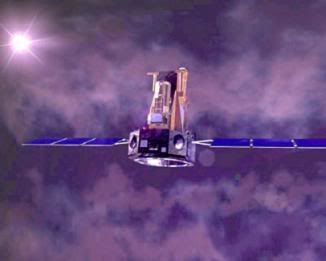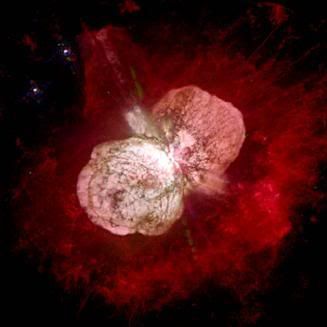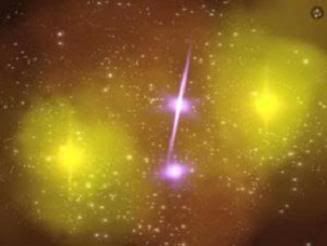Post by glactus on Feb 23, 2008 19:01:21 GMT

The Integra spacecraft
ESA’s Integral has made the first unambiguous discovery of high-energy X-rays coming from a rare massive star at our cosmic doorstep, Eta Carinae. It is one of the most violent places in the galaxy, producing vast winds of electrically-charged particles colliding at speeds of thousands of kilometres per second.

Eta Carinae
The only astronomical object that emits gamma-rays and is observable by the naked eye, Eta Carinae is monstrously large, so large that astronomers call it a hypergiant. It contains between 100–150 times the mass of the Sun and glows more brightly than four million Suns put together. Astronomers know that it is not a single star, but a binary, with a second massive star orbiting the first.

The double stars of Eta carinae
This starlight is so fierce that the stellar winds can reach speeds of 1500–2000 km/s. With two massive stars in close proximity, as they are in the Eta Carinae system, the winds collide and set up fearsome shockwaves where temperatures reach several thousand million degrees Kelvin. “It’s a very tough environment,” says Jean-Christophe Leyder of the Institut d’Astrophysique et de Géophysique, Université de Liège, Belgium.
Understanding this emission is important because astronomers believe that it lies at the heart of many diverse phenomena in the universe. Stellar winds have profound implications on the evolution of stars, the chemical evolution of the universe and as a source of energy in the galaxy.
‘Hard X-ray Emission from Eta Carinae’ by J-C. Leyder, R. Walter and G. Rauw has been accepted for publication in the journal Astronomy and Astrophysics.

To gaze in awe
credits:
This article has been adapted from materials provided by the European Space Agency.
This is part text only. See double star image, full text and all scientists involved at sciencedaly.com
www.sciencedaily.com/releases/2008/02/080221085019.htm
image credit: Integra spacecraft: ESA
www.esa.int/esaCP/ESAOLB094UC_Benefits_1.html
Eta carinae : Hubble: grantchronicles.com
www.grantchronicles.com/astro17.htm




